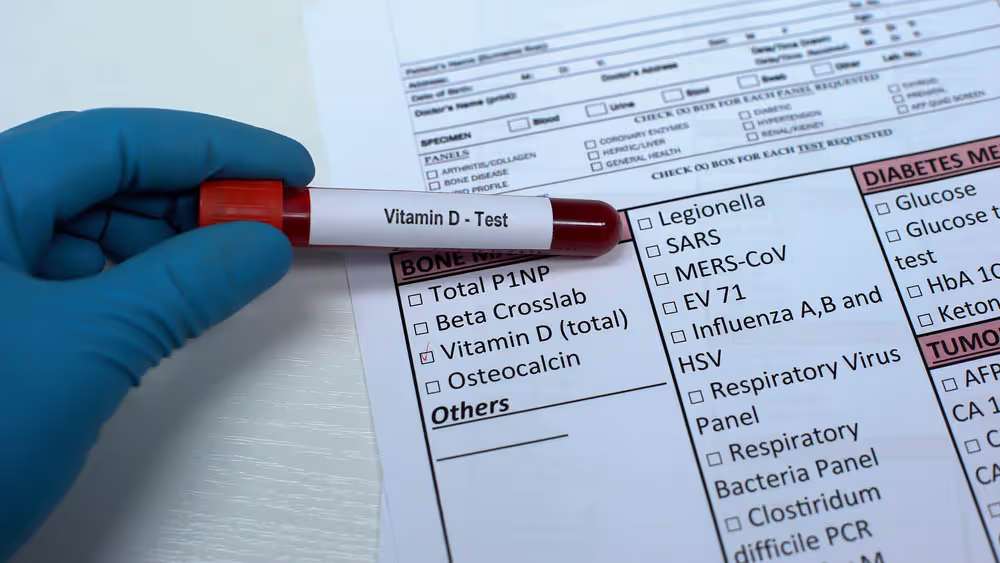Vitamin D Blood Test
Vitamin D plays a powerful role in your bone strength, immunity, mood, and disease risk—but most Australians don’t get enough. This guide explains what vitamin D does, how it’s tested, what affects your levels, and why it matters for long-term health. You'll also learn what low levels mean, how to fix them, and how Everlab helps you stay on top of it all.

Vitamin D Test in Australia: Book Your Vitamin Deficiency Blood Test Today
What:
Blood Biomarker
Tests for:
Bone health, immune function, chronic disease risk
Referral:
Required
Member cost:
$50-$70
What Is Vitamin D?

Vitamin D is a fat-soluble vitamin that plays a critical role in many essential bodily functions. While it’s classified as a vitamin, it actually functions more like a hormone. It helps your body absorb calcium and phosphate, which are vital for building healthy bones, teeth, and muscles. By aiding the body to absorb calcium, vitamin D is essential for bone health. Beyond bone health, vitamin D influences gene expression, supports the immune system and immune response, and even brain function.
There are two major forms of vitamin D:
- Vitamin D2 (ergocalciferol): Found in fortified foods and plant-based supplements. Less potent and shorter-lasting in the body.
- Vitamin D3 (cholecalciferol): Synthesised in your skin via UVB sunlight exposure and found in animal-based foods. More effective at raising and maintaining adequate blood levels.
A deficiency in vitamin D can lead to serious health issues. Low vitamin D levels can result in bone malformation, such as rickets in children and osteomalacia in adults.
Interestingly, vitamin D must be activated through a two-step process in your body: first in the liver, then in the kidneys. This transformation turns it into its active form, calcitriol, which your body uses to perform critical tasks.
How Is Vitamin D Measured?
Vitamin D status is assessed through blood tests that measure 25-hydroxyvitamin D, abbreviated as 25(OH)D. These blood tests are the best marker for overall vitamin D status because they reflect total intake from sun, food, and supplements.
Most labs report your result in nanomoles per litre (nmol/L). To perform the test, a healthcare professional will draw blood from a vein in your arm using a small needle to collect a blood sample, which is then placed into a test tube or vial. Blood tests measure the levels of vitamin D in your body to assess deficiency or toxicity. The vitamin D test measures 25-hydroxyvitamin D, but the test measures can vary depending on which form of vitamin D is being assessed. The test itself is fast and low-risk, but accuracy depends on the method and laboratory used.
Why Is Vitamin D Important?
Vitamin D impacts nearly every system in the body. Vitamin D deficiency is a widespread health issue that can have serious consequences. Research has linked it to the regulation of over 1,000 genes. Here’s what optimal vitamin D levels help with:
- Bone health: Helps absorb dietary calcium and is crucial for a person's bone health. Without enough vitamin D, your body starts leaching calcium from your bones. Bone pain can result from vitamin D deficiency, as low levels may weaken bones and increase the risk of osteoporosis.
- Immune modulation: Reduces inflammation and improves resistance to infections, including respiratory illnesses.
- Neurological health: Deficiency is linked to mood disorders, depression, and even increased Alzheimer’s risk.
- Muscle function: Supports coordination and balance, especially important as you age. Muscle weakness is a common symptom of vitamin D deficiency.
- Cardiovascular health: Emerging evidence connects low levels with arterial stiffness, hypertension, and coronary artery disease.
- Metabolic function: Supports insulin sensitivity and glucose metabolism. Low levels are common in people with type 2 diabetes.
- Autoimmune conditions: Linked to reduced risk of MS, rheumatoid arthritis, and IBD.
There is a significant risk of vitamin D deficiency, especially among high-risk groups such as older adults, people with limited sun exposure, and those with certain medical conditions.
Why Test Your Vitamin D Levels?

You can’t feel your vitamin D level. Most people have no symptoms until they’re severely deficient. A blood test is the only reliable way to know if your levels are in the optimal range. Certain risk factors can increase your chances of developing vitamin D deficiency.
You should consider testing if you:
- Spend most of your time indoors
- Use sunscreen consistently
- Live in southern Australia (especially during winter)
- Have darker skin
- Follow a vegan or dairy-free diet
- Have unexplained fatigue, joint pain, or frequent infections
- Have osteoporosis or low bone density
- Are concerned about low vitamin D levels
Early testing means early intervention. Our team at Everlab uses your results to guide you through supplementation, diet changes, and sun exposure—all tailored to your lifestyle and risk profile. If you are at high risk for vitamin D deficiency, consult your healthcare provider to discuss whether testing is appropriate for you.
What Affects Vitamin D Levels?

Many factors influence your 25(OH)D levels. Understanding these helps us personalise your plan:
Some common risk factors for vitamin D deficiency include limited sun exposure, darker skin pigmentation, older age, obesity, certain dietary habits, and living in northern latitudes.
Gut health or certain medications can affect how your body absorbs vitamin D. Medical conditions such as celiac disease, Crohn's disease, and liver or kidney disorders may also impair vitamin D absorption.
Your diet matters too. While foods like fatty fish, egg yolks, and fortified products provide vitamin D, you may also consider other nutritional supplements to help maintain optimal levels, especially if dietary intake or sun exposure is insufficient.
1. Sunlight Exposure
Your body makes vitamin D when exposed to UVB radiation. But this process is affected by:
- Geographic location: The further from the equator, the lower your year-round UVB exposure.
- Season: Winter months drastically reduce your body’s ability to produce vitamin D naturally.
- Time of day: UVB is strongest around midday.
- Skin coverage: Hats, clothing, and sunscreen block UVB absorption.
- Glass: UVB doesn’t penetrate windows, so indoor sun doesn’t help.
2. Skin Tone
Melanin blocks UVB. People with darker skin need more sun exposure to produce the same amount of vitamin D as lighter-skinned individuals. For example, someone with a dark complexion may need 30–60 minutes of sun, while someone fair might need just 10.
3. Age
As you age, your skin produces less vitamin D. Combined with reduced mobility or outdoor activity, this is why many older Australians are deficient.
4. Diet
Even with a healthy diet, it’s hard to get enough vitamin D through food alone. The richest sources are:
- Fatty fish (salmon, mackerel, sardines)
- Egg yolks
- Fortified foods (some milks, cereals, orange juice)
- Dairy products, especially fortified dairy products
- Mushrooms exposed to UV light
Vitamin D supplements, including vitamin pills and other nutritional supplements, can help maintain adequate vitamin D levels, especially for those with limited dietary intake or sun exposure. It’s important to consult a healthcare provider before taking vitamin D supplements to ensure proper dosage and avoid potential adverse effects.
But these are often inconsistently consumed or not included in plant-based diets.
5. Body Weight
Vitamin D is stored in fat tissue. People with higher body fat percentages often have lower circulating levels because more vitamin D gets sequestered away.
6. Gut Health
Conditions like coeliac disease, Crohn’s disease, or a history of bariatric surgery can reduce your ability to absorb fat-soluble vitamins like vitamin D.
7. Medications
Medications that can lower vitamin D include:
- Glucocorticoids
- Anti-epileptics
- Cholestyramine
- Some HIV and antifungal drugs
8. Genetic Factors
Some people have polymorphisms in genes involved in vitamin D metabolism or transport. This means they may require higher intake or more frequent monitoring.
How to Prepare for a Vitamin D Blood Test
Vitamin D testing is easy and requires minimal prep. Here’s how to get accurate results:
- No fasting needed: Unlike cholesterol or glucose tests, you can eat as normal.
- Tell your doctor about supplements: Especially if you’ve been taking high doses recently.
- Hydrate: Drink plenty of water the day before and of your test.
- Relax: Stress or poor sleep won’t influence results, but staying calm helps the blood draw go smoothly.
What Do Vitamin D Results Mean?

Understanding your test results helps you assess whether you have adequate levels, are at risk of deficiency, or have high vitamin D. Maintaining adequate levels is important for bone and overall health, while high vitamin D or too much vitamin D from supplements can be harmful. Higher vitamin and higher vitamin D levels can be achieved through supplementation or sun exposure, but it is important not to exceed recommended amounts to avoid toxicity.
What If Your Levels Are Low?
Depending on how low your levels are, your doctor may recommend:
- A short-term loading dose of vitamin D (e.g. 50,000 IU weekly)
- Long-term daily maintenance (1,000–4,000 IU)
- Taking vitamin D supplements to address deficiency and prevent complications
- Determining how much vitamin D you need individually, based on factors like sun exposure, diet, and testing
- Adding magnesium to aid absorption
- Getting a DEXA scan to assess bone density
- Repeat testing in 3 months to evaluate response
Risks and Limitations of the Test
- Short-term variability: Levels can shift with recent sun or supplement exposure.
- Doesn’t show active vitamin D: 1,25(OH)2D is the active form but not routinely tested.
- Lab error: Quality and method matter.
- Risk of vitamin D toxicity: Excessive supplementation can lead to toxic levels of vitamin D, which may cause serious health issues. The risk of vitamin D overdose is higher when taking too many vitamin pills, rather than from diet or sun exposure. Always consult a healthcare professional before starting supplements to avoid vitamin D toxicity.
Still, it’s one of the most useful, cost-effective markers for identifying preventable disease risk.
How to Improve Vitamin D Levels

1. Sunshine
Use short, controlled bursts. Ten minutes of midday sun on arms and legs, 3–5 times per week, is often enough for fair-skinned individuals. Consider UV index apps to avoid over- or under-exposure.
2. Foods
Build your diet around vitamin D-rich options:
- 100g salmon = 526 IU
- 1 egg yolk = 37 IU
- 1 cup fortified milk = ~100 IU
Pair with healthy fats (like olive oil) to enhance absorption.
3. Supplements
Safe and effective. Choose D3 (cholecalciferol) unless plant-based, in which case D2 may be used. Start low, test regularly.
Avoid mega doses unless prescribed. Toxicity is rare but possible with sustained high intake.
Sources
1. NIH Office of Dietary Supplements – Vitamin D Fact Sheet for Health Professionals
https://ods.od.nih.gov/factsheets/VitaminD-HealthProfessional
2. RACGP – Vitamin D Testing Guidelines
3. RCPA - Use and Interpretation of Vitamin D Testing
4. Cambridge University Press - Vitamin D and Immune Function: An Overview
5. BMJ - Vitamin D supplementation and major cardiovascular events
Get On Top Of Your Vitamin D Levels
Vitamin D is essential for bone strength, immunity, mood, and long-term health. Low levels are common—and often silent—but easy to test and correct. At Everlab, we include vitamin D as part of a deeper health check, giving you clear, personalised steps to optimise your levels and prevent disease before it starts.
.avif)